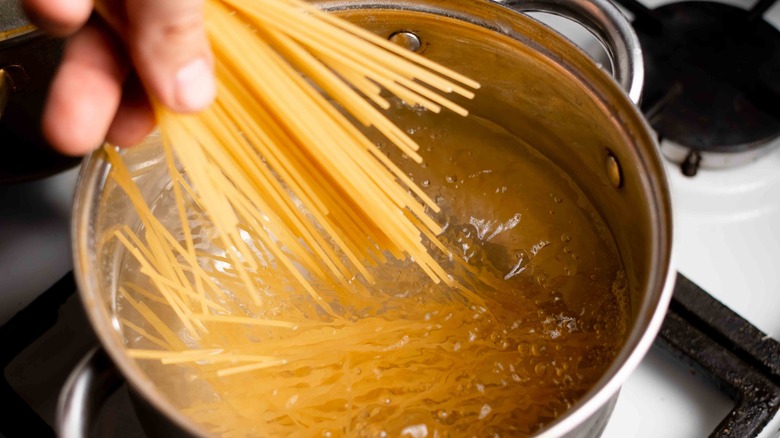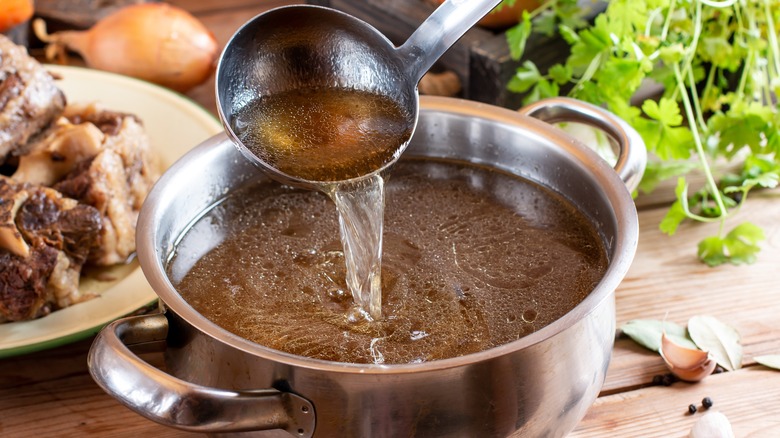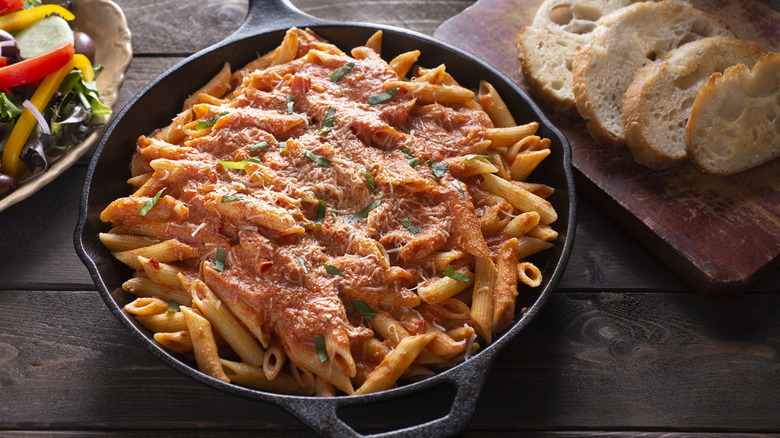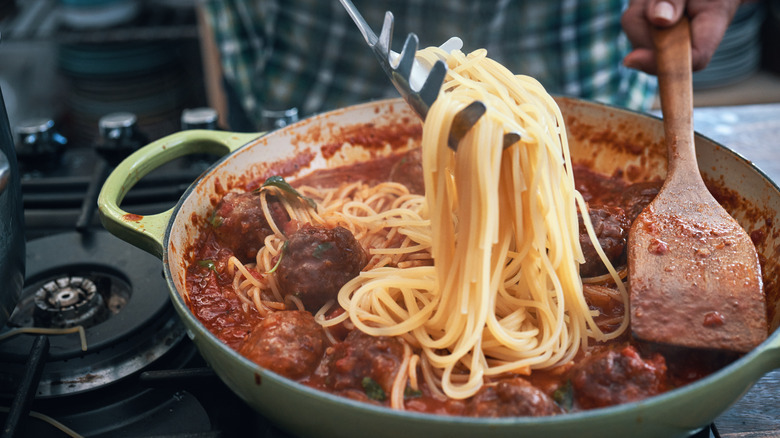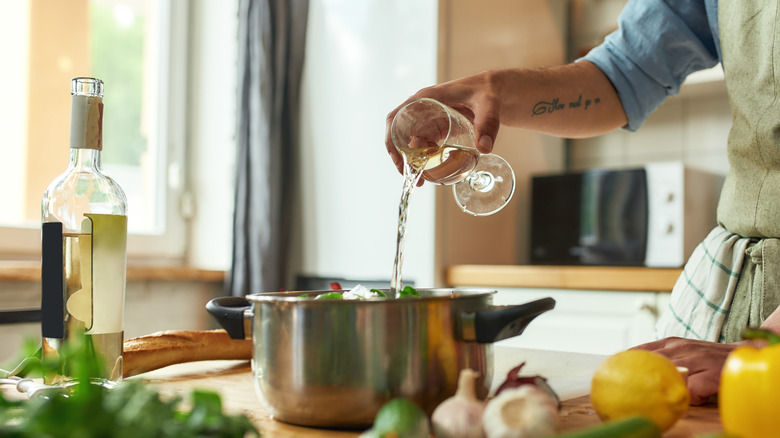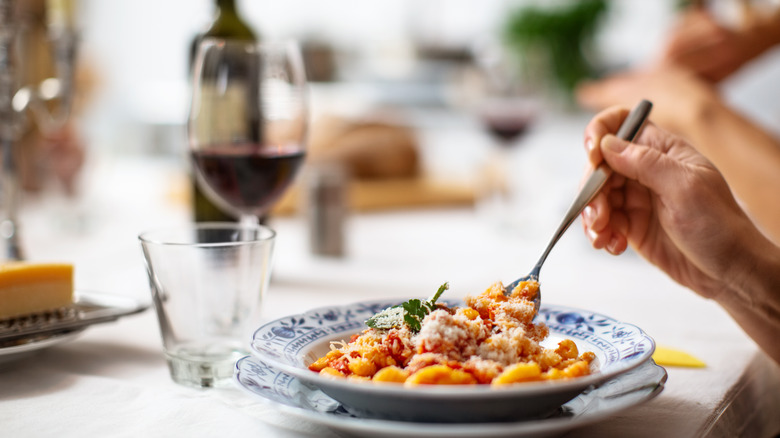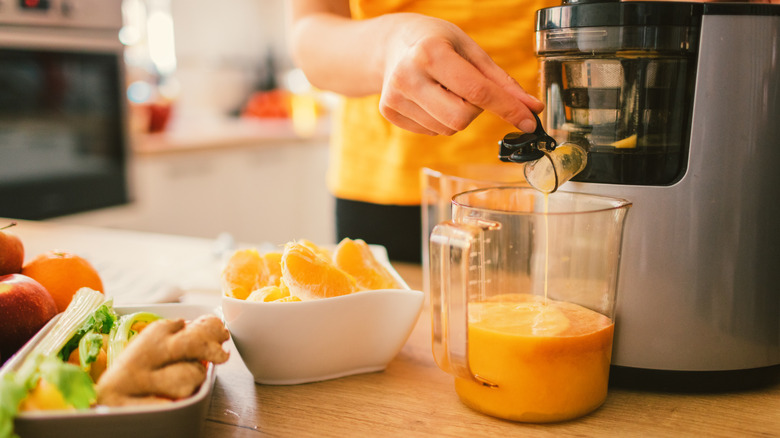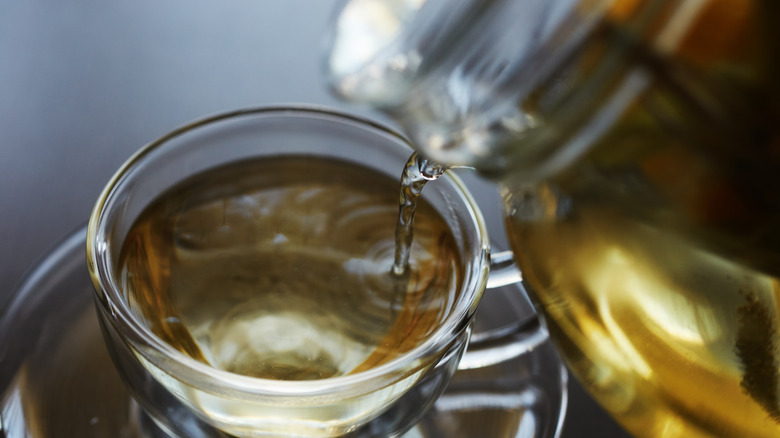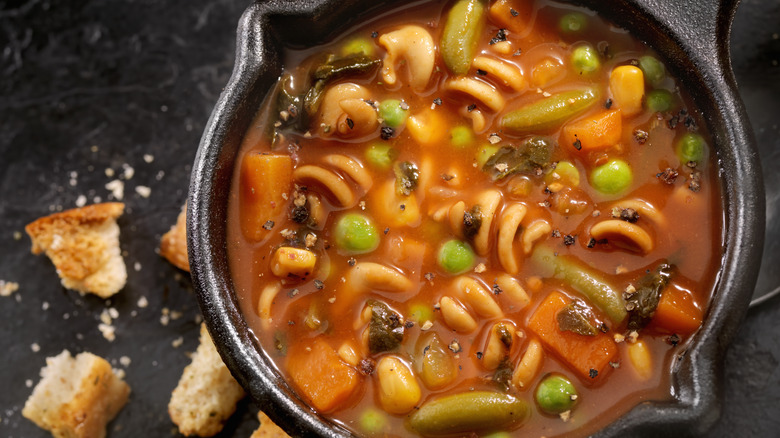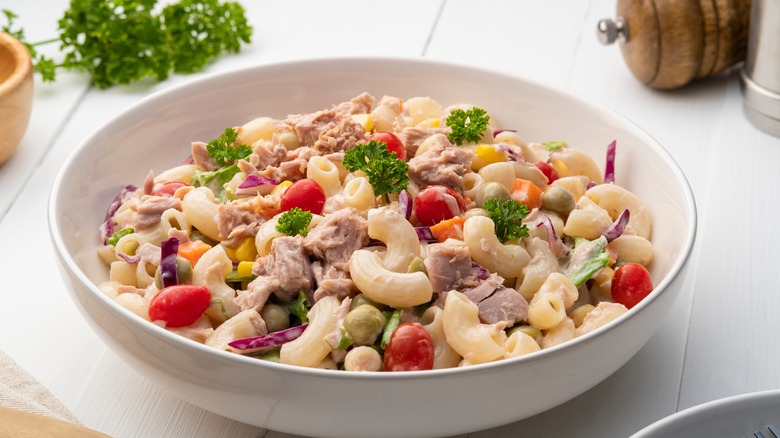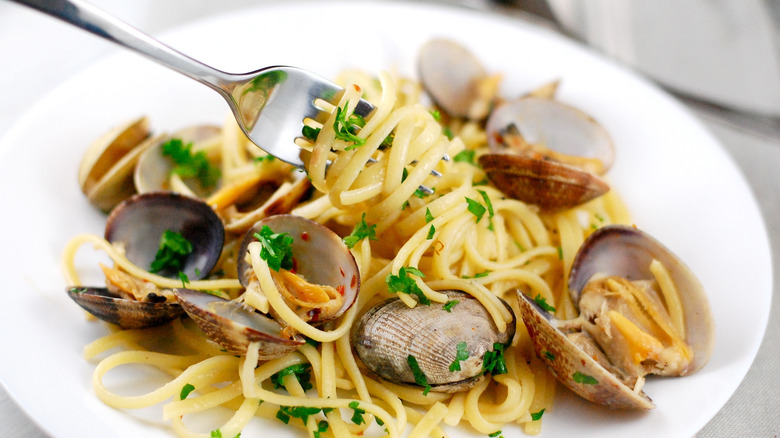Conserve Water And Cook Your Pasta In These Liquids
Simple pasta recipes are the perfect dinner for when you want something comforting, filling, delicious, and straightforward. After a long day, preparing a home-cooked meal can feel like a daunting task. But pasta is still manageable even when you aren't in the mood to cook. Just boil the pasta, then heat your favorite store-bought jar of pasta sauce, or make an easy homemade sauce with just a few ingredients. Toss it all together, add a sprinkling of parmesan cheese, and just like that, you're done. It's a simple and foolproof dish. But there's one step of that process that can be improved, and it doesn't take a lot of extra effort.
Although practically all pasta recipes call for cooking the noodles in a large pot of water, this feels like a waste of both water and a delicious flavor opportunity. Why waste water just to drain most of it when you could use another cooking liquid and infuse the pasta with wonderful flavor as it boils? By consulting expert opinions and personal cooking knowledge, we've compiled a list of surprising and delicious ways to cook your pasta. Turn your go-to last-minute meal into something more special by cooking your pasta in one of these ten flavorful cooking liquids.
Broth or stock
Broth and stock aren't just good for making soup. The savory liquid works wonderfully for making marinades and sauces. And you can also use broth for cooking pasta. The most common way to cook pasta is with salted water, with the salt adding subtle flavor to the noodles. Using broth is similar, except it's much more flavorful than salted water. Cooking pasta in broth or stock works just as well as cooking it in water and is an excellent way to add subtle, savory flavor to your noodles.
Pasta is often considered a plain ingredient used as the base for more boldly flavored sauces. But, using this method, you can make the pasta itself shine. As the noodles cook in the broth or stock, the pasta will soften and absorb some of the flavor. You'll taste the difference after cooking noodles in broth, but the noodles won't be so strongly flavored that they'll overpower the sauce. This method simply adds more depth and layers to the taste of your favorite pasta recipe.
When deciding what broth to use, chicken broth is often a great option because it offers a subtle flavor to plain pasta that isn't overwhelming. The light flavor goes well with a lot of pasta recipes. You can also use other types of broth, like vegetable broth, beef broth, or fish stock. Consider the sauce and protein you plan to use and pick your cooking broth based on what flavors would match best.
Milk
Boiling pasta in milk may sound strange at first, but it's an excellent way to enhance the rich flavor of creamy pasta recipes. Although cooking pasta in milk is a delicious option for rich and decadent pasta recipes, it's not the right choice for every dish. This cooking method is ideal when you're preparing pasta to go with a creamy sauce. Fettucini alfredo, penne ala vodka, and pasta primavera are all rich recipes perfect for pairing with milk-cooked pasta. The enriched pasta pairs beautifully with the creamy sauces, and you can preserve some of the starchy milk to thicken your sauce recipe. Mac and cheese and creamy pasta salads are also made even more delicious by cooking pasta in milk.
A good rule of thumb is to cook pasta in milk if the sauce or dressing you are planning to add includes milk, cream, or a large amount of another dairy product in the recipe. But, if you're making a simple tomato sauce or light, oil-based topping, then it's better to select another cooking liquid, as the rich, milky pasta won't go well with the light sauce.
When cooking pasta in milk, remember that it takes longer than cooking in water. Unlike water, milk can also burn, ruining your pasta recipe. To prevent this, cook the pasta with your milk at a simmer and stir frequently during the cooking time to keep the milk from burning.
Pasta sauce
Instead of cooking dried pasta in a separate pot of boiling water, why not add it directly to your pasta sauce? This method adds flavor, reduces cleanup, and helps to thicken the sauce. It's a common cooking tip to preserve a portion of pasta water in order to add it to your sauce. This is because the water becomes starchy after cooking the pasta. That starchiness helps thicken and smooth sauce recipes for the perfect silky texture. You'll get the same result by cooking pasta directly in the sauce, as the starchy pasta helps thicken the sauce while it cooks. The process also benefits the pasta, which is lightly flavored by the delicious sauce as it cooks.
Cooking pasta in the sauce will take more time than cooking in water, but it cuts extra steps out of your recipe. Instead of cooking the pasta separately, draining and setting it to the side while you prepare the sauce, you'll add it directly to your sauce pot. So, you don't have to worry about cleaning an extra pot or your pasta getting cold and sticking together while you prepare the sauce. This cooking method is best when you're making sauce-heavy recipes. You can cook your pasta in a large pot of classic tomato sauce or a rich, creamy pasta sauce. But, if you're making a light butter sauce or something simple to dress your noodles, there won't be enough liquid to cook the pasta.
White wine
Let's talk wines! If you're an Italian food lover, then you know how much of a difference pairing your dinner with the right glass of wine can make. And you've likely made recipes that call for a splash of wine in the sauce to enhance the flavors with its acidity. But, you may not have considered the possibility of cooking your pasta directly in wine. If you're a fan of pasta in wine sauce, consider how much more flavorful you can make your favorite dish by cooking the pasta directly in the wine. According to Italy Magazine, cooking pasta in wine is a long-standing tradition in Liguria, Italy, where "Pasta alla Deficeira" was created as a celebratory dish after a successful olive harvest.
Just like adding wine to your sauce recipes, cooking your pasta in wine acts as a flavor booster for the entire recipe. Even after draining the pasta, the wine flavor will remain, so the wine you choose is important. You don't need to break the bank on the most expensive bottle, but you do want one that you like the flavor of and that pairs well with your sauce. Pinot Grigio and unoaked Chardonnay are both good cooking wine options. When cooking pasta in wine, it's essential to consider the sauce and protein. White wine goes best with creamy dishes, seafood, and chicken recipes, but you won't want to use it if you're adding your pasta to a red sauce or serving it with beef.
Red wine
Just like with white wine, cooking pasta in red wine adds flavor and acidity to your dish. It's a great option for recipes that you'd typically pair with a glass of red wine, such as spaghetti Bolognese or sugo all amatriciana. The wine will also brighten the flavors of your pasta sauce. After using it to cook the pasta, add a little bit of the starchy wine to your sauce to help flavor and thicken the mixture.
Although cooking with wine is common and delicious, it's important to keep the alcohol content in mind. You've likely heard that alcohol cooks out of recipes, and this is partially true. During the cooking time, the alcohol cooks down, leaving a lightly acidic and sweet taste. However, it takes several hours for alcohol to completely cook out of dishes. In fact, more alcohol remains than you may think. After 15 minutes of cooking, approximately 40% of the original alcohol content remains. And even after 2 hours of cooking, about 10% is still present. The remaining alcohol isn't enough to get you drunk or be a problem for most people, but it is something to keep in mind and consider when adding wine to your dishes.
Fruit juice and vegetable juice
Although cooking with wine is great for flavor, it has its drawbacks. You may not like having alcohol in the house. Or perhaps the cost of a bottle of wine simply to drain most of it from your pasta feels wasteful. But there's another option that has many of the same flavor benefits. Instead of cooking with water or wine, try making your next pasta recipe with juice. Similar to wine, this nonalcoholic option simultaneously cooks your noodles and infuses them with flavor. Cooking in juice may also color your pasta.
Pick a fruit or vegetable juice that complements the flavors of the pasta dish you're making for an enhanced dining experience. The most obvious option is cooking your pasta in tomato juice before serving it with a delicious red sauce. However, other juice options, such as red cabbage juice, carrot juice, and zucchini juice, can add subtle and delicious flavor to your pasta. Fruit juices like white grape juice make a good wine alternative.
You can purchase juice at the grocery store or make fresh vegetable or fruit juice with a juicer. When cooking pasta with juice, it's best to opt for one without a lot of added sugar or flavoring, as you don't want to make your pasta recipe ultra-sweet. You just want to lightly boost the flavor and add some acidity. Feel free to also add complementary flavors with herbs, spices, onions, garlic, and other aromatic ingredients.
Green tea
Once you start thinking outside the box with your cooking, there are so many ways for you to change up simple recipes and make them into something you never imagined. Cooking pasta in plain water is the obvious way to prepare it, but after you start thinking of other cooking liquids, the delicious options just keep coming. One more to add to your list of possibilities is cooking your noodles in tea. Although you likely won't like the flavor of cooking pasta in sweet or black tea, green tea is a surprising and delicious way to prepare your pasta. Use part plain water and part tea for a subtle hint of flavor that enhances but doesn't take over your recipe.
Cooking in green tea adds a complex and herbal flavor to your pasta. It's ideal for when you're making fresh, vegetable, or herby dishes. For example, you can add dimension to a simple weeknight meal, like pasta in garlic and herbs sauce, by cooking the pasta in green tea before adding the simple buttery sauce. Cooking in tea is also a good option for pesto or a creamy spinach pasta sauce.
For this method, you can opt for teas that have flavors you know go well with pasta, such as rosemary tea. And don't be scared to experiment with different kinds of teas and pasta for the best combination. Tea is also a unique and effective ingredient for adding to sauces, marinades, and broth recipes.
Soup or stew
There are many different ways to enjoy pasta, and one particularly enticing on a cold evening is adding pasta to a hearty soup or stew recipe. But, it's a waste of water (and dishes) to cook the pasta in a separate pot from the rest of your meal. The next time you're preparing vegetable, chicken, or beef soup, don't worry about cooking the pasta separately. Instead, add it directly to your soup pot to cook until tender. This is essentially the same as cooking your noodles in broth, except that you'll be getting even more flavors from the vegetables, herbs, spices, and meat in your soup or stew recipe.
Dry pasta cooks fairly fast, so you'll want to add it to soup towards the end of the cooking time. If you add the noodles at the beginning and let them simmer the entire time, you'll end up with unpleasant and mushy pasta. Typically, pasta is going to be the last ingredient you add to the soup pot. After combining all the other ingredients, toss in the noodles and let them simmer on the stovetop until tender. This can take anywhere from 5 to 15 minutes, depending on the size of your pasta. Check the noodles periodically to ensure that you don't overcook them in the soup. These cooking times are in regards to cooking on the stovetop, but it can take a few hours to cook your pasta in a slow cooker.
Pickle brine
When selecting an alternative cooking liquid for your pasta instead of water, it's important to consider how you're using the pasta. Although using pickle brine to cook pasta may sound crazy, there are occasions when it's a brilliant idea. True, if you're preparing something like spaghetti and meatballs, infusing your spaghetti noodles with pickle flavor is not ideal. However, the bright, tangy flavor offered by the pickle brine is an excellent way to pump up the flavors in creamy pasta salad, shrimp pasta salad, and other similar recipes.
Pickle brine is the vinegar-based liquid used to pickle vegetables. After finishing off a jar of pickles, the brine is what's left in the jar. While you could throw away the brine and clean the jar, saving it to use in another recipe is a great way to reduce kitchen waste. You can seal the jar and store leftover pickle brine in the fridge until you use it to cook pasta.
Because pickle brine has a strong flavor, and you likely won't have a lot of it on hand, you'll want to use part pickle brine and part water to cook your pasta. One Reddit user said they used a 5-to-1 ratio of water to brine, which gave their pasta just the right amount of tangy flavor. If you prefer not to use plain water, you can combine the pickle brine with a more mellow cooking liquid, such as chicken broth, for lightly savory, tangy, and tender pasta.
Clam juice
Clam juice is a powerful flavor booster. It's a common ingredient in Bloody Marys and is often added to sauces, chowders, and other seafood recipes. You can also use it to cook your pasta and infuse it with unexpected and delicious flavor. Clam juice is made from the salted liquid used to steam clams. After cooking the clams, the clam juice has a briny, umami flavor, which helps enhance the natural flavors of seafood dishes. You'll love the salty seafood flavor it adds to noodles. Consider cooking your pasta in clam juice the next time you're serving pasta with seafood. White clam sauce linguine and creamy seafood pasta are some enticing recipes you could make with clam-sauce-cooked pasta.
If you're going to use this method, you can purchase a bottle of clam sauce at the grocery store; it's often stocked next to canned seafood. Alternatively, you can make your own clam juice by preserving the cooking liquid after steaming clams. If you don't want to use your whole bottle of clam juice to cook pasta but still want that flavor, try using part clam juice and part fish stock or chicken stock to cook your pasta. And don't forget to add a splash of the starchy clam juice mixture to your sauce recipe.
